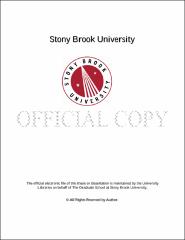| dc.identifier.uri | http://hdl.handle.net/11401/76468 | |
| dc.description.sponsorship | This work is sponsored by the Stony Brook University Graduate School in compliance with the requirements for completion of degree. | en_US |
| dc.format | Monograph | |
| dc.format.medium | Electronic Resource | en_US |
| dc.language.iso | en_US | |
| dc.publisher | The Graduate School, Stony Brook University: Stony Brook, NY. | |
| dc.type | Dissertation | |
| dcterms.abstract | Receptors that activate the heterotrimeric G protein Gαq are thought to play a role in the development of heart failure. Dysregulation of autophagy occurs in some pathological cardiac conditions including heart failure, but whether Gαq is involved in this process is unknown. A cardiomyocyte-specific transgenic mouse model of inducible Gαq activation (termed GαqQ209L) was used to address this question. Autophagy is a quality control and recycling process in which double-membrane vesicles called autophagosomes enclose intracellular materials and send them to lysosomes for degradation. After 7 days of Gαq activation, GαqQ209L hearts contained more autophagic vacuoles than wild type (WT) hearts. Increased levels of proteins involved in autophagy, including Vps34, Beclin1, Atg7, Atg14, p62 and LC3-II, were also seen. Real-time quantitative PCR showed a 4-fold upregulation in p62 mRNA and a small increase in Atg7 mRNA, but mRNAs encoding the other proteins were not transcriptionally upregulated. Inhibition of the Ca2+-dependent protease calpain, whose activity is increased in GαqQ209L hearts, did not block the increase in LC3-II protein, suggesting that increased autophagy is not due to calpain activation. LysoTracker staining and western blotting showed that the number and size of lysosomes and lysosomal protein levels were increased in GαqQ209L hearts, indicating enhanced lysosomal degradation activity. Importantly, an autophagic flux assay measuring LC3-II turnover indicated that autophagic activity is enhanced in GαqQ209L hearts. GαqQ209L hearts exhibited elevated levels of the Class III phosphoinositide 3-kinase (Vps34) complex. As a consequence, Vps34 activity and phosphatidylinositol 3-phosphate levels were higher in GαqQ209L hearts than WT hearts, thus accounting for the higher abundance of autophagic vacuoles. These results indicate that an increase in autophagy is an early response to Gαq activation in the heart. | |
| dcterms.abstract | Receptors that activate the heterotrimeric G protein Gαq are thought to play a role in the development of heart failure. Dysregulation of autophagy occurs in some pathological cardiac conditions including heart failure, but whether Gαq is involved in this process is unknown. A cardiomyocyte-specific transgenic mouse model of inducible Gαq activation (termed GαqQ209L) was used to address this question. Autophagy is a quality control and recycling process in which double-membrane vesicles called autophagosomes enclose intracellular materials and send them to lysosomes for degradation. After 7 days of Gαq activation, GαqQ209L hearts contained more autophagic vacuoles than wild type (WT) hearts. Increased levels of proteins involved in autophagy, including Vps34, Beclin1, Atg7, Atg14, p62 and LC3-II, were also seen. Real-time quantitative PCR showed a 4-fold upregulation in p62 mRNA and a small increase in Atg7 mRNA, but mRNAs encoding the other proteins were not transcriptionally upregulated. Inhibition of the Ca2+-dependent protease calpain, whose activity is increased in GαqQ209L hearts, did not block the increase in LC3-II protein, suggesting that increased autophagy is not due to calpain activation. LysoTracker staining and western blotting showed that the number and size of lysosomes and lysosomal protein levels were increased in GαqQ209L hearts, indicating enhanced lysosomal degradation activity. Importantly, an autophagic flux assay measuring LC3-II turnover indicated that autophagic activity is enhanced in GαqQ209L hearts. GαqQ209L hearts exhibited elevated levels of the Class III phosphoinositide 3-kinase (Vps34) complex. As a consequence, Vps34 activity and phosphatidylinositol 3-phosphate levels were higher in GαqQ209L hearts than WT hearts, thus accounting for the higher abundance of autophagic vacuoles. These results indicate that an increase in autophagy is an early response to Gαq activation in the heart. | |
| dcterms.available | 2017-09-20T16:50:21Z | |
| dcterms.contributor | Brown, Deborah A | en_US |
| dcterms.contributor | Lin, Richard Z | en_US |
| dcterms.contributor | Cohen, Ira S | en_US |
| dcterms.contributor | Zong, Wei-Xing | en_US |
| dcterms.contributor | Liu, Lixin. | en_US |
| dcterms.creator | Liu, Shengnan | |
| dcterms.dateAccepted | 2017-09-20T16:50:21Z | |
| dcterms.dateSubmitted | 2017-09-20T16:50:21Z | |
| dcterms.description | Department of Molecular and Cellular Biology | en_US |
| dcterms.extent | 97 pg. | en_US |
| dcterms.format | Application/PDF | en_US |
| dcterms.format | Monograph | |
| dcterms.identifier | http://hdl.handle.net/11401/76468 | |
| dcterms.issued | 2016-12-01 | |
| dcterms.language | en_US | |
| dcterms.provenance | Made available in DSpace on 2017-09-20T16:50:21Z (GMT). No. of bitstreams: 1
Liu_grad.sunysb_0771E_12811.pdf: 3368991 bytes, checksum: d646f91a66dac7b467a09393cd0e4da7 (MD5)
Previous issue date: 1 | en |
| dcterms.publisher | The Graduate School, Stony Brook University: Stony Brook, NY. | |
| dcterms.subject | Cellular biology -- Molecular biology | |
| dcterms.subject | Autophagy, Electron microscopy, G-alpha-q, Heart Failure, p62 aggregation, Vps34 Activity | |
| dcterms.title | G-alpha-q Regulation on Cardiac Autophagy | |
| dcterms.type | Dissertation | |

